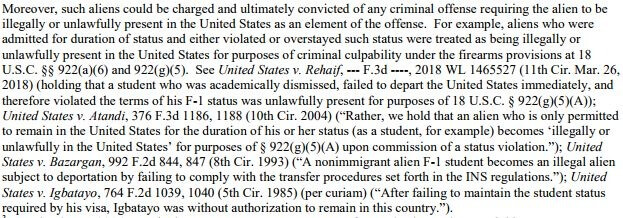- Updates on Litigation
- Introduction
- Background and Previous Policies
- New Policies
- Effective Date
- Status Violations and Overstays Prior to Effective Date
- Status Violations and Overstays After Effective Date
- Situations in Which Unlawful Presence is Generally Not Accrued
- Effect on Reinstatement of F1 or M1 Status
- Effect of Denial of Extension of Status or Change of Status on Unlawful Presence
- Conclusion
Updates on Litigation
On May 3, 2019, Judge Loretta C. Briggs of the United States District Court for the Middle District of North Carolina entered a nationwide preliminary injunction against the implementation of the new unlawful presence rules discussed in USCIS PM-602-1060 and USCIS PM-602-1060.1. Guilford College v. McAleenan, 1:18CV891 (M.D. N.C. 2019) [PDF version]. The plaintiffs made several claims against the validity of the policy, including that it violated the Administrative Procedures Act (APA), violated the INA, was arbitrary and capricious, and violated Due Process protections. The case will continue to be litigated while the preliminary injunction remains in place. Please follow our site for further updates on the litigation as it moves forward.
Introduction
On May 10, 2018, the United States Citizenship and Immigration Services (USCIS) released Policy Memorandum (PM)-602-1060, titled “Subject: Accrual of Unlawful Presence and F, J, and M Nonimmigrants.” The USCIS made the PM available for public comment. The USCIS took the public comments that it received into consideration and released a revised version of the PM with the same name [PM-602-1060.1]. The superseding PM-602-1060.1 is nearly identical to the original except in how it handles cases where F, J, and M nonimmigrants seek reinstatement of status and have their applications granted. In this article, we will discuss the guidance in PM-602-1060.1. You may see the original superseded PM here: [PDF version].
The PM changes how the USCIS will calculate the accrual of unlawful presence for F nonimmigrant students, J exchange visitors, and M vocational students, as well as F, J, and M derivative spouses and children. In short, under the previous policies of the Department of Homeland Security (DHS) and the legacy Immigration and Naturalization Service (INS), unlawful presence was typically counted as of the day after the USCIS made a formal determination that the F, J, or M nonimmigrant had committed a status violation. Under the new rules, the USCIS will calculate unlawful presence as of the day after the F, J, or M nonimmigrant either commits a status violation or fails to maintain his or her status, regardless of when this comes to the attention of the USCIS. The new unlawful presence rules took full effect on August 9, 2018.
Unlawful presence is significant in the context of the 3- and 10-year bars of inadmissibility. If an alien accrues certain amounts of unlawful presence and subsequently departs the United States, he or she may be subject to either the 3- or the 10-year bar of inadmissibility, depending on the facts of his or her case and the length of unlawful presence. We discuss the 3- and 10-year unlawful presence bars in a separate comprehensive article on site [see article].
In this article, we will examine the new PM and the USCIS’s impending rules on the accrual of unlawful presence for F, J, and M nonimmigrants. We will update the article if the USCIS ultimately makes revisions to the new policy based on public comments.
Background and Previous Policies
Before examining the new policies regarding the accrual of unlawful presence for F, J, and M nonimmigrants, it is important to understand the previous policies that are being superseded by the instant memorandum.
The PM explains that the DHS, since its inception, has followed legacy-INS policy on the accrual of unlawful presence for F, J, and M nonimmigrants. On May 6, 2009, the USCIS released a comprehensive memorandum on counting the accrual of unlawful presence generally that was titled “Consolidation of Guidance Concerning Unlawful Presence for Purposes of Sections 212(a)(9)(B)(i) and 212(a)(9)(C)(i)(I) of the Act” [PDF version]. As we noted in the introduction, we discuss this memorandum in detail in a separate article on site [see article]. The 2009 unlawful presence memorandum consolidated existing DHS policy regarding the calculation of the accrual of unlawful presence for F, J, and M nonimmigrants.
The now-superseded 2009 unlawful presence memorandum set forth rules for the accrual of unlawful presence for F and J nonimmigrants admitted for, or present in the United States in, duration of status, and, alternatively, for F, J, and M nonimmigrants admitted until a specific date (date certain).
F and J nonimmigrants admitted for, or present in the United States in, duration of status, began to accrue unlawful presence on whichever of the following days came first:
The day after the USCIS formally found a nonimmigrant status violation while adjudicating a request for another immigration benefit; or
The day after an immigration judge ordered the applicant excluded, deported, or removed (whether or not the decision is appealed).
F, J, and M nonimmigrants admitted until a date certain began accruing unlawful presence on whichever came first between:
The day after USCIS formally found a nonimmigrant status violation while adjudicating a request for another immigration benefit; or
The day after an immigration judge ordered the applicant excluded, deported, or removed (whether or not the decision is appealed).
The instant PM notes that, under the former policies, “an alien admitted for duration of status who overstayed or violated such status did not immediately begin accruing a period of unlawful presence for purposes of INA 212(a)(9)(B).” Such an alien would be removable under section 237(a)(1)(C) of the INA [see section] for having violated his or her nonimmigrant status or any conduction of his or her entry, but he or she would not, on the basis of the overstay or status violation, begin accruing unlawful presence. Thus, while the alien would not be shielded from removal, he or she would not immediately begin accruing unlawful presence toward one of the unlawful presence bars.
In a separate point that is nevertheless worth noting, the same footnote in the instant PM explains that under the former policies such an alien could also be subject to certain criminal provisions, separate of civil immigration laws, which require that he or she have been illegally or unlawfully present. This latter point regarding certain criminal statutes is unaffected by the new PM. For your reference, we have excerpted the footnote in the pertinent part below:

Although the prior policies were consolidated in the 2009 unlawful presence memorandum and added to the USCIS’s Adjudicator’s Field Manual (AFM) at that time, they had originally taken effect in 1997 under the former INS. In the instant PM, the USCIS explains that the INS had crafted the policies “prior to the creation of some of the technologies and systems currently used by DHS to monitor nonimmigrants who are admitted to the United States in or otherwise acquire F, J, and M nonimmigrant status.” To this effect, the new PM provides examples of the DHS’s new capabilities for monitoring F, J, and M nonimmigrants. It explains in that section that in fiscal year 2016, “it was estimated that the total overstay rate [of the 1,457,556 F, J, and M nonimmigrants who were either expected to change status or depart the United States] was 6.19 percent for F nonimmigrants, 3.80 percent for J nonimmigrants, and 11.60 percent for M nonimmigrants.” The USCIS explains that its new policies are designed to reduce the number of overstays of F, J, and M nonimmigrants in light of the DHS’s current capabilities for monitoring individuals in the United States in such statuses.
New Policies
Having explained the prior INS/DHS policy on the accrual of unlawful presence for F, J, and M nonimmigrants, we now move to examine the new policies that went into effect on August 9, 2018. The following sections will cover the effect of the August 9, 2018 implementation date for the new rules, the new rules themselves, and various special cases.
Effective Date
The effective date of the new policy is August 9, 2019.
Status Violations and Overstays Prior to Effective Date
An F, J, or M nonimmigrant who fails to maintain his or her nonimmigrant status before August 9, 2018, will begin accruing unlawful presence based on that failure on August 9, 2018 provided that he or she is not otherwise protected from accruing unlawful presence. However, the August 9 start-date does not apply if the alien had already begun accruing unlawful presence on the earliest of the following:
The day after DHS denied the request for an immigration benefit, if DHS made a formal finding that the alien violated his or her nonimmigrant status while adjudicating a request for another immigration benefit;
The day after the Form I-94, Arrival/Departure Record, expired, if the F, J, or M nonimmigrant was admitted for a date certain; or
The day after an immigration judge or, in certain cases, the Board of Immigration Appeals (BIA), ordered the alien excluded, deported, or removed (whether or not the decision is appealed).
In short, if any of the aforementioned scenarios occurs with an alien prior to August 9, 2018, he or she will start accruing unlawful presence under the previous rules prior to the effective date of the new policy. However, in a case covered only by the new policy and not the previous rules, such as where the alien commenced violation of his or her F, J, or M nonimmigrant status before August 9, 2018, where none of the above points apply, he or she would begin accruing unlawful presence only on August 9, 2018 [see section].
Before continuing, it is important to reiterate that the concept of “unlawful presence” is distinguishable from that of being “out of status.” Thus, as we noted in the previous section of this article, an alien may be removable for a status violation under the pre-August 9 rules while not accruing unlawful presence toward the 3- and 10-year bars of inadmissibility.
Status Violations and Overstays After Effective Date
The new policy took full effect beginning on August 9, 2018. It applies to all F, J, and M nonimmigrants, including their dependents, who are not otherwise protected from accruing unlawful presence. It applies equally to F and J nonimmigrants admitted for duration of status and to F, J, and M nonimmigrants admitted for date certain.
If an F, J, or M nonimmigrant fails to maintain his or her status on or after August 9, 2018, he or she will begin accruing unlawful presence on the earliest of any of the following:
The day after the F, J, or M nonimmigrant no longer pursues the course of study or the authorized activity, or the day after he or she engages in an unauthorized activity;
The day after completing the course of study or program (including any authorized practical training plus any authorized grace period, as outlined in 8 C.F.R. 214.2);
The day after the Form I-94 expires, if the F, J, or M nonimmigrant was admitted for date certain; or
The day after an immigration judge or, in certain cases, the BIA orders the alien excluded, deported, or removed (whether or not the decision is appealed).
A DHS officer will determine the date on which an alien failed to maintain his or her F, J, or M nonimmigrant status. In footnote 6 of the PM, the USCIS set forth several examples of status violations for F, J, and M nonimmigrants:
The F, J, or M nonimmigrant is no longer pursuing the course of study or authorized activity before completing his or her course of study or program;
The F, J, or M nonimmigrant engages in an unauthorized activity (e.g., unauthorized employment);
The F, J, or M nonimmigrant remains in the United States after completing his or her course of study or program (including any authorized practical training plus any authorized grace period, as outlined in 8 C.F.R. 214.2); or
The F, J, or M nonimmigrant, admitted for date certain on his or her Form I-94, remains in the United States beyond such date.
Under 8 C.F.R. 103.2(b)(16), “if an adverse decision will result from a DHS officer’s inadmissibility determination under [the unlawful presence provisions in] INA 212(a)(9)(B) or INA 212(a)(9)(C)(i)(I), and that determination is based on derogatory information of which the alien is unaware, the officer will generally give the alien an opportunity to rebut the derogatory information.”
The PM explains that USCIS officers should consider the following information “[w]hen assessing whether an F, J, or M nonimmigrant accrued unlawful presence and was no longer in a period of stay authorized”;
Information contained in the systems available to USCIS;
Information contained in the alien’s record; and
Information obtained through a Request for Evidence (RFE) or Notice of Intent to Deny (NOID), if any.
Regarding RFEs and NOIDs, the USCIS assessment is made under the preponderance of the evidence (weight of the evidence) standard as set forth in Matter of Chawathe, 25 I&N Dec. 369, 375-76 (AAO 2010) [PDF version].
In is important to note that the above list of sources that USCIS officers should consult in determining whether an F, J, or M nonimmigrant accrued unlawful presence and was no longer in a period of stay authorized is non-exhaustive. USCIS officers may consider other applicable evidence in making a determination.
The new policy applies to the dependents of F2, J2, and M2 nonimmigrant. The period of stay authorized for these dependents admitted for duration of status or for date certain is contingent on the associated F1, J1, or M1 nonimmigrant. Thus, the period of stay authorized for an F2, J2, or M2 nonimmigrant dependent ends when the period of stay authorized for the associated F1, J1, or M1 nonimmigrant. However, it is important to note that, while the period of stay authorized for the derivative F2, J2, or M2 depends on the associated F1, J1, or M1, the same is not true in the reverse. A derivative F2, J2, or M2 nonimmigrant may violate his or her status independent of the F1, J1, or M1, through his or her “own conduct or circumstances.”
Finally, it is important to reiterate that the new policies apply only to F, J, and M nonimmigrants. The existing rules regarding the accrual of unlawful presence for all other aliens are unaffected.
Situations in Which Unlawful Presence is Generally Not Accrued
First, it is important to note that, under section 212(a)(9)(B)(iii)(I) of the INA, aliens under the age of 18 do not accrue unlawful presence. Thus, notwithstanding any of the foregoing policies, an F, J, or M nonimmigrant does not accrue unlawful presence provided that he or she is under the age of 18.
The PM edits to the AFM include cases in which F, J, and M nonimmigrants generally do not accrue unlawful presence. We will list these cases for your reference.
F nonimmigrants generally do not accrue unlawful presence in the following non-exhaustive list of situations:
During the allowable 30-day period before the program start date listed on the F1 nonimmigrant’s Form I-20, permitted under 8 C.F.R. 214.2(f)(5)(5);
While the F1 nonimmigrant is pursuing a full course of study at an educational institution approved by DHS for that purpose, including any additional periods of authorized pre- or post-completion practical training, and including authorized periods of employment under 8 C.F.R. 214.2(f)(1)(ii)(E);
During a change in educational levels as described in 8 C.F.R. 214.2(f)(5)(ii), provided that the F1 nonimmigrant follows the transfer procedures outlined in 8 C.F.R. 214.2(f)(8);
While the F1 nonimmigrant is in a cap-gap period under 8 C.F.R. 214.2(f)(5)(vi) [see article];
While the F1 nonimmigrant has a pending application for post-completion Optional Practical Training (OPT) under 8 C.F.R. 214.2(f)(10)(ii)(D);
While the F1 nonimmigrant is pursuing a school transfer, provided that he or she maintained status in accordance with the provisions of 8 C.F.R. 214.2(f)(8);
The period of time a timely-filed reinstatement application under 8 C.F.R. 214.2(f)(16) is pending with USCIS (application will not be considered to be “timely filed” if applicant was out of status for more than 5 months prior to applying for reinstatement);
The period of time an F1 nonimmigrant was out of status if he or she applies for reinstatement under 8 C.F.R. 214.2(f)(16), provided that the application is ultimately approved;
During annual vacation permitted for F1 nonimmigrants under 8 C.F.R. 214.2(f)(5)(iii), provided that the F1 nonimmigrant is eligible and intends to re-register for the next school term;
During any additional grace period permitted under 8 C.F.R. 214.2(f)(5)(iv) to prepare for departure (60 days following completion of course of study and authorized practical training; 15 days if the designated school official (DSO) authorized the withdrawal from classes. Note that no grace period applies if F1 nonimmigrant failed to maintain full course of study without approval of DSO or otherwise failed to maintain status;
Emergent circumstances as outlined in 8 C.F.R. 214.2(f)(5)(v), in which any or all of the requirements for on-campus or off-campus employment are suspended by a Federal Register notice and the student reduces his or her full course of study as a result of accepting employment based on the Federal Register notice; and
During an period of reduced course load authorized by the DSO in accordance with 8 C.F.R. 214.2(f)(6)(H)(iii).
J nonimmigrants generally do not accrue unlawful presence in the following non-exhaustive list of situations:
The period of time, as annotated on the Form DS-2019, as the approved program time or any applicable grace period, either before the program start date or after the conclusion of the program, in accordance with 8 C.F.R. 214.2(j)(1)(ii);
Any extension of program time annotated on the Form DS-2019 as outlined in 8 C.F.R. 214.2(j)(1)(iv);
While the J1 nonimmigrant is in a cap gap period as outlined in 8 C.F.R. 214.2(j)(1)(vi); and
The period of time a J1 nonimmigrant was out of status, if he or she is granted reinstatement under 22 C.F.R. 62.45.
M nonimmigrants generally do not accrue unlawful presence in the following non-exhaustive list of situations:
The period of admission as indicated on the Form I-94, including up to 30 days before the report or start date listed on the Form I-20, as outlined in 8 C.F.R. 214.2(m)(5);
Any authorized grace period described in 8 C.F.R. 214.2(m)(5);
During the time the M1 nonimmigrant completes authorized practical training covered in 8 C.F.R. 214.2(m)(14);
The period of a timely-filed reinstatement application under 8 C.F.R. 214.2(m)(16) is pending with USCIS (the application will not be considered to be “timely-filed” if the applicant was out of status for more than 5 months at the time of filing for reinstatement); and
The period of time an M1 nonimmigrant was out of status if he or she applies for reinstatement under 8 C.F.R. 214.2(m)(16), provided that the application is ultimately approved.
Effect on Reinstatement of F1 or M1 Status
The main changes from the first version of the F, J, and M unlawful presence PM to the second dealt with reinstatement applications. The USCIS outlined the changes in a news release [PDF version].
Under the new policies, the accrual of unlawful presence will be suspended for F and M nonimmigrants while a timely-filed reinstatement of status application is pending. As we noted, “timely-filed” in the context of the accrual of unlawful presence excludes reinstatement applications that are filed after the F or M nonimmigrant has been out of status for more than 5 months. If the reinstatement application is denied, the F or M nonimmigrant will resume accruing unlawful presence from the date of denial. If the reinstatement application is approved, the time that the F or M student was out of status will generally not be treated as unlawful presence, including cases in which the F or M student sought reinstatement after having been out of status for more than 5 months. To learn about reinstatement of F and M status, please see our full articles on reinstatement of F1 status [see article] and reinstatement of M1 status [see article].
The new PM also addresses reinstatement of J1 status, which was not addressed at all in the original version. While the USCIS adjudicates applications for reinstatement of F1 or M1 status, J1 reinstatement applications are handled by the U.S. Department of State (DOS). The new PM states that in the event that the DOS grants an application for reinstatement of J1 status, the USCIS will generally not count the period from the time at which the J1 nonimmigrant fell out of status to the time at which reinstatement was granted as unlawful presence.
The changes to the PM regarding reinstatement of status are generally favorable to nonimmigrant student and exchange visitors and highlight the fact that the USCIS often considers public comments before finalizing new policies.
Effect of Denial of Extension of Status or Change of Status on Unlawful Presence
The PM explains that if an application for extension of status (EOS) or change of status (COS) is denied because the application was deemed to be frivolous or because the alien engaged in unauthorized employment, the EOS or COS application will not protect the alien from accruing unlawful presence. The same applies if the application for EOS or COS is denied on the basis of it having been untimely filed.
Conclusion
The new policies on the accrual of unlawful presence for F, J, and M nonimmigrants are highly unfavorable in cases where nonimmigrants in these classes commit a status violation or stay in the United States beyond the time authorized. Generally, F, J, and M nonimmigrants will begin accruing unlawful presence from the time they violate their status or remain beyond the period of stay authorized, whereas under the previous rules, unlawful presence generally began accruing from the time such was adjudicated. Whether under the old rules or new rules, it is imperative for F, J, and M nonimmigrants to be cognizant of the rules of their status and to carefully follow them. However, the new rules make it even more important for F, J, and M nonimmigrants to carefully follow the rules and be aware that it is now far easier to accrue unlawful presence after breaching status. As we noted in the introduction, the 3- and 10-year unlawful presence bars have a highly deleterious effect on an alien’s future prospects for entering the United States as either an immigrant or nonimmigrant.
In order to remain in status, an F, J, or M nonimmigrant should familiarize him or herself with the rules of status and work closely with his or her DS (in the case of an F or M nonimmigrant) or exchange program (in the case of a J nonimmigrant). When in any doubt about his or her status, an F, J, or M nonimmigrant should consult with an experienced immigration attorney. It is always best to air on the side of caution when considering the potential adverse consequences of violations of the terms of admission for an F, J, or M nonimmigrant.





